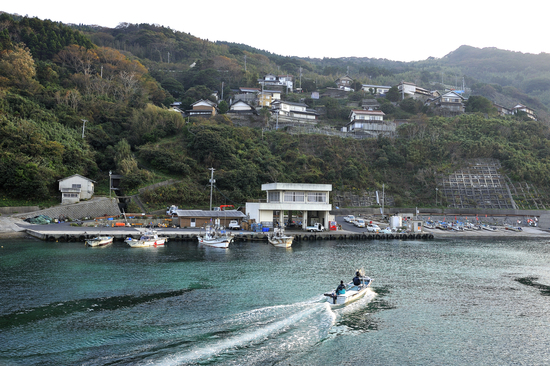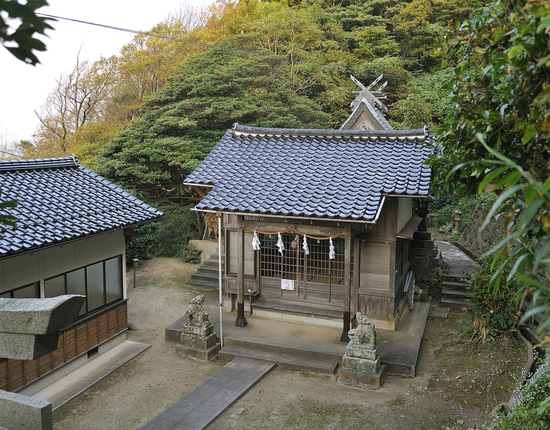Ino-ura
| Bay Name | Ino-ura | |
|---|---|---|
| Shrine Name | Sazuchi-jinja | |
| Deity |
|
|
| Location |
Izumo-shi Chigou-cho 168 |

In the original 42-bay pilgrimage, Takubi Gongen is actually the shrine listed for worship by the pilgrims for Ino Bay. In terms of modern day land delineation for the Ino area, the current shrine is Satsuchi-jinja. Naturally, as its name suggests, the enshrined deity is Kunisatsuchi-no-mikoto. In fact, a look at the entry for Ino-mura, Akika Province in the Unyoushi tells us of the shrines ‘Takubi Gongen: deity Mikahayahi-no-mikoto’ and ‘Hachioji: deity Kunisatsuchi-no-mikoto’ showing that originally there were two separate shrines.
Mention of ‘Takubi’ reminds us of ‘Takubi-jinja’ in Nishi-no-shima on the Oki Islands. Oki can be reached from Ino, that journey would have been done following the transfer of a divided kami, in this case a kami of voyages, to grant a smooth journey across. Mikahayahi is a kami of fire. Fire would offer a guiding light over waters (like a lighthouse today) so such a kami would be held in very high regard. The enshrined deity of Takubi jinja on Oki island is Oohirume-no-muchi, that naming didn’t occur until the late 17th century but the transfer to Ino of the Takubi Gongen was long before that.
In 1871, Takubi-jinja which had been enshrined in the town of East Chigou was enshrined together with Hachioji-jinja from West Chigou. The shrine, Satsuchi-jinja, as it is called today, was named so after enshrined deity from the Hachioji shrine, Kunisatsuchi-no-mikoto.
The grounds of Satsuchi-jinja are in a village formed in a steep hill. Despite the narrow area, it has a peaceful atmosphere befitting a shrine. It is built in the ‘Kasuga’ style of construction. Just under the main hall is a small model in the style of a shrine, perhaps in acknowledgement of Takubi-jinja before the merger. Upon entering, the hall next to the Torii gate the gods of Takubi and the ancient buddhas which are now so familiar to us are all calmly present. The prayers of the people of Chigou for safe voyages can be granted by the combined strength of both Shinto and Buddhist deities.

If visiting Satsuchi-jinja on way from Saka-ura to Ino-ura, caution is needed for oncoming vehicles on the very narrow 1km stretch of road that will take you to the shrine. If approaching from Onoze town, you need to take the highway on the opposite side of Ono-machi that has a road sign leading to Ichibata-Yakushi. By following this road from East to West Chigou, the Ono-ura fishing harbor will come into view. The drive from Saka Ura right over to Ko-ura offers some amazing sunset views but nightfall follows soon after so be careful about running out of gas before attempting the mountain roads on the way to Ko-ura.
Satsuchi-jinja was actually rebuilt on November 17th 2012 but the locals still maintain the memorial stones nearby which are dedicated to unknown dead that were found washed up at Ino-ura in the past perhaps after some accident s at sea. The ‘Tondo Festival’ here begins with the pounding and offering of mochi (rice cakes) and then sees a Kagura performance by Elementary and Junior High school students. From around 7pm to about 12 midnight various Shinto traditions are carried out like the banishing of the Orochi Serpent. These were traditionally carried out during the Meiji Period but since the war events organized by the neighborhood council have also been well attended and enjoyed. The Ebisu Festival on May 13 sees rocks collected from the sea on the East side of Ino-uraPort. The marine life found on them are offered up and then returned to the sea in order to ask for safety and good fishing hauls.
| Bay Name | Ino-ura | |
|---|---|---|
| Shrine Name | Sazuchi-jinja | |
| Deity |
|
|
| Location |
Izumo-shi Chigou-cho 168 |
In the original 42-bay pilgrimage, Takubi Gongen is actually the shrine listed for worship by the pilgrims for Ino Bay. In terms of modern day land delineation for the Ino area, the current shrine is Satsuchi-jinja. Naturally, as its name suggests, the enshrined deity is Kunisatsuchi-no-mikoto. In fact, a look at the entry for Ino-mura, Akika Province in the Unyoushi tells us of the shrines ‘Takubi Gongen: deity Mikahayahi-no-mikoto’ and ‘Hachioji: deity Kunisatsuchi-no-mikoto’ showing that originally there were two separate shrines.
Mention of ‘Takubi’ reminds us of ‘Takubi-jinja’ in Nishi-no-shima on the Oki Islands. Oki can be reached from Ino, that journey would have been done following the transfer of a divided kami, in this case a kami of voyages, to grant a smooth journey across. Mikahayahi is a kami of fire. Fire would offer a guiding light over waters (like a lighthouse today) so such a kami would be held in very high regard. The enshrined deity of Takubi jinja on Oki island is Oohirume-no-muchi, that naming didn’t occur until the late 17th century but the transfer to Ino of the Takubi Gongen was long before that.
In 1871, Takubi-jinja which had been enshrined in the town of East Chigou was enshrined together with Hachioji-jinja from West Chigou. The shrine, Satsuchi-jinja, as it is called today, was named so after enshrined deity from the Hachioji shrine, Kunisatsuchi-no-mikoto.
The grounds of Satsuchi-jinja are in a village formed in a steep hill. Despite the narrow area, it has a peaceful atmosphere befitting a shrine. It is built in the ‘Kasuga’ style of construction. Just under the main hall is a small model in the style of a shrine, perhaps in acknowledgement of Takubi-jinja before the merger. Upon entering, the hall next to the Torii gate the gods of Takubi and the ancient buddhas which are now so familiar to us are all calmly present. The prayers of the people of Chigou for safe voyages can be granted by the combined strength of both Shinto and Buddhist deities.
If visiting Satsuchi-jinja on way from Saka-ura to Ino-ura, caution is needed for oncoming vehicles on the very narrow 1km stretch of road that will take you to the shrine. If approaching from Onoze town, you need to take the highway on the opposite side of Ono-machi that has a road sign leading to Ichibata-Yakushi. By following this road from East to West Chigou, the Ono-ura fishing harbor will come into view. The drive from Saka Ura right over to Ko-ura offers some amazing sunset views but nightfall follows soon after so be careful about running out of gas before attempting the mountain roads on the way to Ko-ura.
Satsuchi-jinja was actually rebuilt on November 17th 2012 but the locals still maintain the memorial stones nearby which are dedicated to unknown dead that were found washed up at Ino-ura in the past perhaps after some accident s at sea. The ‘Tondo Festival’ here begins with the pounding and offering of mochi (rice cakes) and then sees a Kagura performance by Elementary and Junior High school students. From around 7pm to about 12 midnight various Shinto traditions are carried out like the banishing of the Orochi Serpent. These were traditionally carried out during the Meiji Period but since the war events organized by the neighborhood council have also been well attended and enjoyed. The Ebisu Festival on May 13 sees rocks collected from the sea on the East side of Ino-uraPort. The marine life found on them are offered up and then returned to the sea in order to ask for safety and good fishing hauls.






